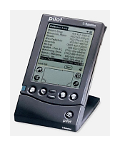What You Need to Know About the Gogoro!
One of the coolest things from CES I saw from the Techpodcasts Network coverage was the Gogoro scooter and it’s cool design for batteries. Check out this video!
Join Dr. Bill as he examines the wild and wacky world of the web, computers, and all things geeky! Hot Tech Tips, Tech News, and Geek Culture are examined… with plenty of good humor as well!
One of the coolest things from CES I saw from the Techpodcasts Network coverage was the Gogoro scooter and it’s cool design for batteries. Check out this video!
 Cross-posted from Hand Held Hack
Cross-posted from Hand Held Hack
What? I don’t think so!
Palm is being brought back from the dead
Variety – By: Marc Graser – “Chinese electronics maker TCL, which spent considerable coin to rename Mann’s Chinese Theater in Hollywood, has acquired the rights to revive the once-dominant maker of digital personal organizers.
TCL said at the Consumer Electronics Show in Las Vegas this week that it will re-create Palm in Silicon Valley, after having purchased the brand’s assets from Hewlett-Packard late last year. HP had paid $1.2 billion to purchase Palm in 2010, but sold off the company’s webOS operating system to LG in 2013, leaving TCL with little other than nostalgia to work with.
‘Palm has always carried a lot of affect and emotions,’ TCL said in a statement. ‘That’s why TCL has set the direction to rebuild the brand involving Palm’s very own community, making it the largest scale crowdsourced project ever seen in the industry.’
The company will set up a new Palm Inc. in Silicon Valley. It also will back the development of new Palm products with 5,000 engineers and seven research and development centers around the world.
TCL, which is a substantial producer of electronics in China, with its line of TVs and mobile devices, is still relatively unknown in the U.S., although it’s looking to change that through high-profile placements in movies like ‘Iron Man III,’ and naming-rights deals like the one in Hollywood.
It also owns the Alcatel OneTouch brand through which it produces lower priced smartphones Stateside. The new Palm products are likely to become the company’s more high-end line of mobile devices.
Palm was founded in 1992 and had various owners, including US Robotics and 3Com. Its devices essentially established the handheld market, especially among business execs, with the Treo and Pilot, and opened the door for rivals like BlackBerry to step in and take over.
Palm isn’t the only mobile brand trying to make a comeback.
Lenovo is trying to breathe new life into Motorola after buying it last year, with three new smartphones it will launch in China this year. The new Moto X rolls out in February.”
Cross-posted from VirtZine – Cloud developers will love this new Fedora!
6 new things Fedora 21 brings to the open source cloud
OpenSource.com – By: Jason Baker – “When Fedora 21 finally hit release last month, I was excited and ready to go. By the end of the day, I had every desktop machine I own up and running on the new version, and I was enjoying playing with the latest version of some of my favorite open source software which was packaged inside. But what next?
The desktop edition of Fedora 21 was just one of three “flavors” of Fedora. What do the other two hold, and what do they mean for Fedora outside of the workstation?
A flavor just for cloud
So what is this flavor thing? For the newest release, the Fedora Project split the distribution into three different focuses: A version for desktop users, focused on workstation usage; a server edition, focused on traditional infrastructure needs; and a cloud image, for those who want to use Fedora in a virtualized environment. The cloud flavor packs only the essentials and is packaged to be deployed on your favorite cloud of choice.
A smaller image size
When you’re talking about paying for space for hundreds of virtual machines, or even just waiting for a configured image to upload from your local machine to your cloud environment, size matters. The Fedora maintainers made strong progress bringing down the base size of the Fedora cloud image for the new release. Cloud images now clock in at a 10% smaller size than the previous release, with a qcow2 formatted version under 200MB.
An atomic image
Atomic Cloud is now available in Fedora 21. Atomic makes Fedora work better with Linux container projects, like Docker, by creating a way to roll back upgrades as a group that can be easily rolled back if something goes wrong. This, combined with tools for easier management and orchestration of container-based applications, make Atomic a great host for containerized applications. For more on Atomic and what it means for both Fedora and the cloud, visit the Project Atomic homepage.
New workstation tools for cloud developers
Some of what was exciting for cloud developers wasn’t in the cloud flavor at all, but in the workstation. Fedora 21 comes with a new tool called DevAssistant, which makes getting started with creating new development projects easier than ever. DevAssistant pulls together all of the key parts needed to deploy an application, sets up your directories, downloads any needed dependencies, and puts everything together for you in one easy pacakge. If you’re writing software for the cloud, you’ll want to check it out.
You in the cockpit
Another great tool shipping in Fedora is called Cockpit. Cockpit is a management console that makes it easy for you to manage multiple Linux servers via a web browser. It’s a great tool for beginner system administrators to perform simple tasks like administering storage and starting and stopping services. While not as versatile as some other solution, Cockpit is easy to learn and easy to use.
A new OpenStack
Finally, Fedora 21 is set up for a new version of OpenStack. By default, Fedora 21 is designed to work with OpenStack Icehouse, released last year, but you can also try it out with latest Juno release via RDO.
You also might be interested in checking out the official release notes for additional information about some of the features found in Fedora 21, and in particular what they mean for those operating or doing development in a cloud environment.”
 The new S1 chip may be a Samsung!
The new S1 chip may be a Samsung!
Apple Watch May Run Samsung Processor
China Topix – David Curry – “A new rumor suggests Apple might have contracted Samsung to be the primary manufacturer for the S1 chip, the processor inside the upcoming Apple Watch.
Like Us on Facebook
Apple reportedly has acquired 3,000 to 4,000 12-inch wafers every month from Samsung, in an attempt to have sufficient hardware units before the launch in spring, according to ZDNet.
Each 12-inch wafer has 700 processors, meaning Apple will be grabbing 2.5 million new processors every month. By the time the Apple Watch launches, Apple should have a healthy supply of available processors.
Samsung will supply 20-nanometer chips, the new standard Apple is looking to attain with all processors. Reports say this is one of the reasons Samsung was originally dropped by Apple as primary manufacturer, due to TSMC’s 20-nanometer capabilities.
Apple will also be adding several health and fitness sensors inside the smartwatch, allowing users to better track personal health. Notifications will also play a big part on the Apple Watch, a new interface has been built just to make usability even easier.
The Apple Watch is still one of the most anticipated smartwatch launches, despite companies like LG, Samsung, Motorola and Alcatel already launching Android alternatives.
Analysts predict up to 30 million sales in 2015 for Apple Watch, a huge number considering the first place smartwatch, the Galaxy Gear, has only sold 1 million units in over a year. The large international pull could bring customers from China and Japan into smartwatches, even though the current trend seems to be phablets.
Apple will need to pull out all of the stops on the Apple Watch – but we still do not know the price-tag for the three available ‘Editions’ of the watch.”
 How cool is this? Just like Tesla, Toyota is Open Sourcing patents! This is awesome!
How cool is this? Just like Tesla, Toyota is Open Sourcing patents! This is awesome!
Following Tesla’s Lead, Toyota Makes Fuel Cell Patents Free
LiveScience – By: Tanya Lewis – “Toyota is making thousands of its hydrogen fuel cell patents available royalty-free, the car company announced this week at CES 2015 in Las Vegas.
The company will make more than 5,600 fuel cell patents available through 2020 to carmakers who produce and sell fuel cell vehicles, and to parts suppliers and companies interested in building and operating fueling stations, said Bob Carter, Toyota’s senior vice president of automotive operations.
The carmaker hopes the move will spur worldwide development and innovation in fuel cell technologies. It comes on the heels of a similar decision by billionaire entrepreneur Elon Musk to make the patents of his electric car company, Tesla Motors, freely available. [10 Technologies That Will Transform Your Life]
‘The first-generation hydrogen fuel cell vehicles, launched between 2015 and 2020, will be critical, requiring a concerted effort and unconventional collaboration between automakers, government regulators, academia and energy providers,’ Carter said in a speech at CES.
Carter said Toyota has a ‘long history’ of sharing its intellectual property, citing as an example the firm’s licensing of patents for hybrid vehicles. But this is the first time Toyota is making its patents available for free, a move that ‘reflects the company’s aggressive support for developing a hydrogen-based society,’ Carter said.
Companies that make fuel cell busses and industrial equipment can also receive the patents, and requests from non-transportation companies will be evaluated on a case-by-case basis, he said.
The announcement applies only to patents wholly owned by Toyota. Fuel cell vehicle-related patents will be available royalty-free until the end of 2020, while hydrogen-production and supply patents will remain free indefinitely.
Toyota also encouraged other companies to share their fuel cell patents.
Carter said his company provided substantial funding for the development of hydrogen fueling infrastructure in California and the northeastern United States. In May 2014, the car maker announced a $7.3 million loan to the Newport Beach, California-based hydrogen fueling company FirstElement Fuel to help maintain nearly 20 fueling stations across the state.
In November 2014, Toyota announced a collaboration with French multinational Air Liquide to design and supply a network of 12 hydrogen stations for New York, New Jersey, Massachusetts, Connecticut and Rhode Island.”
Imagine one device on your network that would “filter” your home network traffic and cleanse it of all virii, malware, etc.! Well, that is just what Bitdefender BOX does, for $199.00, which comes with a year of updates, support, etc. Then it will be $99.00 a year to stay protected… for your whole house… all your devices. Not too shabby!
“Advanced Threat Protection
Not just for your computers. Everything. Once connected to the Internet, every device, even Smart TVs, smart appliances like fridges, thermostats or gaming consoles are vulnerable to malware that silently does its work. BOX protects everything else that’s in the home: PCs, Macs, Android and iOS tablets and phones alike. Just like an antivirus for your home network.
Management and Control
Use the smart phone app to remotely install OS updates, identify vulnerabilities or system issues, make performance improvements and tune-ups, control mobile data roaming and tethering settings on family devices. All available in one app, at your fingertips, anywhere you are.
Private Line
The BOX protects your mobile devices so you can use hotspots without being vulnerable to viruses, hackers and privacy thieves even when away from home.
Connect the BOX to your Wi-Fi router
Plug in the included power supply and connect it to the BOX using the USB cable, then connect the BOX to any available Ethernet port on your Wi-Fi router using the included cable.
Set it up
Download the app from the AppStore or Google Play. Choose the ‘Connect BOX to your router’ in the app. That’s it. BOX automatically applies the settings it needs.”
Microsoft’s new browser might be kinda cool. How’s that for weird?
Windows 10’s new browser will have the most advanced features ever
The Verge – By: Tom Warren – “Microsoft is planning to radically overhaul its web browser in Windows 10. Sources familiar with the company’s Windows plans tell The Verge that the new browser, codenamed Spartan, will include a host of new features not found in rival browsers. Chief among the plans for Spartan is new inking support that allows Windows 10 users to annotate a web page with a stylus and send the notes and annotations to a friend or colleague. The web note service will be powered by Microsoft’s OneDrive cloud storage, meaning notes will be stored on a copy of a web page that can be accessed by any browser across multiple platforms. As annotations are shared, multiple users can doodle on a web page and share edits and annotations between groups.
A second major feature for Spartan will be the integration of Microsoft’s Cortana digital assistant. Microsoft is planning to use Cortana to surface information on flights, hotel bookings, package tracking, and other data within the traditional address bar. If you use Cortana to track a particular flight and start to search for ‘American Airlines’ in the browser address bar, it will automatically display tracked flights and allow Spartan users to view the status of the flight directly. It’s a subtle addition, but you’ll also be able to access Cortana search directly from the new tab interface in Spartan. Cortana integration in the Spartan browser is planned to replace every instance of the existing Bing methods in Internet Explorer.
Other features include a new way to group tabs together to declutter the occasionally messy interface of multiple browser tabs. Spartan will allow users to group tabs however they want, making it easier, for example, to split up personal tabs from work ones. Microsoft also originally planned to allow Spartan to support custom themes, but we understand the company has dropped this for the final new browser in Windows 10. Such support may arrive in future updates.
Spartan is designed to be a single browser across PCs, tablets, and phones. We’re told that Microsoft will make Spartan a Windows Store app, enabling the company to quickly and easily update the browser in future. ZDNet previously reported that Microsoft will continue to include Internet Explorer in Windows 10, and we understand this will be primarily for legacy compatibility reasons. Spartan is the main browser in Windows 10, and most users will be accessing the web using it. While Spartan will be a Windows Store app, we understand Microsoft isn’t planning to make it a universal app initially. One version of Spartan will be available in the Store as a desktop app, and another as a modern app for tablets and phones. Both will be updated regularly with identical features.
Microsoft is planning to keep the look and feel of Spartan very similar across phones, tablets, and PCs. The desktop version looks like a simplified version of Chrome, with a tabbed interface above the address bar, alongside options to go back, forward, and refresh a page. It’s all designed to look lightweight, without the bloat typically associated with older versions of Internet Explorer. While the Spartan name is a codename, it’s not clear if Microsoft plans to continue the Internet Explorer branding with its new browser. That naming and other features of Spartan could play a part in Microsoft’s Windows 10 event on January 21st. Microsoft is planning to detail the consumer features of Windows 10 at its press event later this month, including its phone and tablet features.
We reached out to Microsoft for comment on its Windows 10 browser plans, but a spokesperson says the company has ‘nothing to share.'”
Click HERE for CES Live Coverage from Techpodcasts Network!
Podcast: Play in new window | Download (54.2MB) | Embed
Subscribe: RSS
Geek Culture abounds in this abbreviated holiday edition with Dr. Bill’s son, Benjamin, AKA, the GameMaster, and his epic short video project from his freshman year in college in Electronic Communications… ‘How to Be a Ninja!’
Links that pertain to this Netcast:
International Association of Internet Broadcasters
 |
|
 |
 |
| Download M4V | Download WebM | Download MP3 | Download Ogg |
 |
 |
Podcast: Play in new window | Download (Duration: 4:31 — 4.2MB) | Embed
Subscribe: RSS
Geek Culture abounds in this abbreviated holiday edition with Dr. Bill’s son, Benjamin, AKA, the GameMaster, and his epic short video project from his freshman year in college in Electronic Communications… ‘How to Be a Ninja!’
Links that pertain to this Netcast:
International Association of Internet Broadcasters
 |
|
 |
 |
| Download M4V | Download WebM | Download MP3 | Download Ogg |
 |
 |